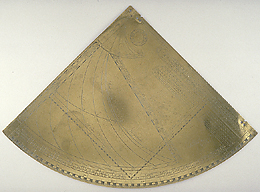
 |
| Catalogue |
 |
 Quadrant The unequal hour quadrant is very small and close to the tip of the instrument; the hour lines are numbered 1 to 6 to 12. Close to this quadrant is a circle with the planetary symbols. The equal hour quadrant is much larger and more dominant on the instrument; the hour lines are numbered twice: 4 to 12 to 8 near the curved edge and 6 to 12 to 6 along the equinoctial line. The upper part of the noon line (closer to the curved edge) is inscribed 'Horae aestivales', the lower part 'Horae hyemales'. Along the left-hand edge is a date scale marked with the Latin names of the months numbered from 1 to 12 starting with March. The scale has divisions of circa 5 days. The equinoxes correspond to circa 11 March and 13 September. This scale and a corresponding zodiacal scale (marked with the usual Latin names and the symbols and numbered 1 to 12 starting with Aries, each sign divided to 5?) to the right of the hour scales serve to set the now missing plumb bob. Superimposed on the markings for the equal hours is a shadow scale to the base 60, numbered by 10 and divided to 5 and 1. The scale is inscribed 'Vmbra Versa' and Vmbra Recta'. The latitude for which the quadrant was laid out and the date are given on the left-hand edge close to the tip as 'Anno Domini 1551 Polus 51.34'. Along the right hand edge are the following inscriptions: 'Fluxus aqua celer est et Fulminis ictus. Ast magis his tacitum tempus utris<que> celer.' ' Illud metiri quadrans tamen iste docebit. Et quota sit fias certior hora facit.' 'Omni negotio temous est oportunitas. Salom.' The last inscription is partially obliterated by two drilled holes which - together with another set closer to the tip and two corresponding cut outs once served for the fixing of the sighting vanes, now missing. Further to the inside, along the same right-hand edge is an Easter table ('Tab{ula} Pas{chalis}') with the possible dates for Easter between 22 March and 25 April with the corresponding Day Letters and Golden Numbers. Further to the inside are tables for the first years of each lunar cycle ('Reuolutiones Cycli Lunae') and solar cycle ('Reuolutiones Cycli Solis'). The table for the lunar cycle has 16 entries in 19 year intervals, the first being the year 1539 and the last the year 1824. The table for the solar cycle has 13 entries in 28 year intervals, the first being the year 1532 and the last the year 1868. Below this table are the initials 'W.B.' Along the curved edge is an altitude scale 0? to 90?, numbered by 10? and divided to 5? and single degrees. Further to the inside along the same edge are scales for the solar cycle (to the left) and the lunar cycle (to the right). Between the two scales are the initials 'J C'. The solar cycle ('Ciclus Solis') gives the full 28 years and the corresponding Dominical Letters ('Litera Dominicalis') for ordinary and leap years ('Bisextilis'), starting with F / G for the first year of the cycle. The lunar cycle ('Ciclus Lunae') gives the full 19 years and the corresponding epacts ('Epacta'). The usual table of epacts is shifted by one year, so that the list starts with 11 for the first year of the cycle. On the left hand side of this table is the inscription 'Edwardus Rex'. The back of the instrument has markings for a sine / cosine quadrant with a regular scale 0? to 90? (numbered by 10? and divided to 5? and single degrees) along the curved edge and an irregular scale 0? to 90? to 0? (numbered by 5? and divided to single degrees) along the right edge. At the top right corner are the initials 'T.G.' The instrument was purchased in 1858 and is described and illustrated in F. A. B. Ward, A Catalogue of European Scientific Instruments in the Department of Medieval and Later Antiquities of the British Museum (London, 1981), pp. 56-7 (with plate XIX). Silke Ackermann |



